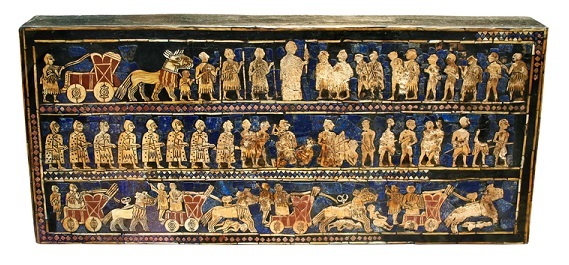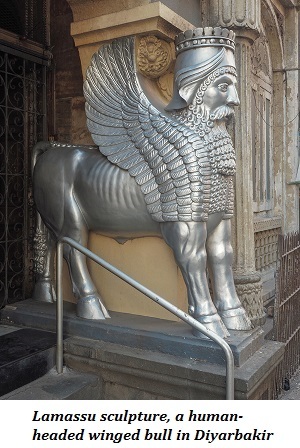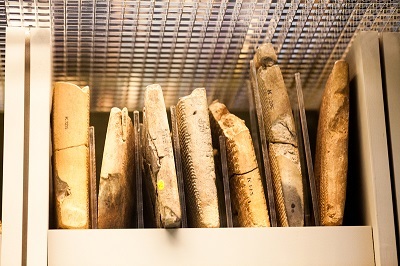

Babylonian art is the art produced in the city of Babylon in ancient Mesopotamia (present-day Iraq) during the 2nd and 1st millennia BC. The art reflects the culture, beliefs, and daily life of the people who lived in Babylon, and it was heavily influenced by the art of the Sumerians, Akkadians, Assyrians, and Persians.
Characteristics of Babylonian art include the use of bright colors and intricate details, as well as the depiction of religious and mythological subjects and scenes from daily life. The city of Babylon was also known for its impressive architectural achievements, such as the Hanging Gardens, one of the Seven Wonders of the Ancient World.

An ancient artifact known as the Standard of Ur
Babylon was an important cultural and artistic center in the ancient world. Its art and architecture influenced the surrounding regions, including the Elamites, Assyrians, Persians, and later the Greeks and Romans.
The city was known for its impressive architectural achievements, including the Hanging Gardens, one of the Seven Wonders of the Ancient World, the Ishtar Gate and the palace of Nebuchadnezzar II.
The city also had a strong tradition of sculpture and relief work, which can be seen in examples such as the Stele of Hammurabi and the Lamassu sculptures.
The city was also renowned for its artisans who created intricate and detailed works such as cylinder seals, jewelry, and other decorative objects.
Babylon's art was heavily influenced by Sumerian and Akkadian art, as well as the art of the Assyrians and Persians. The city was also an important religious center, and its art often depicted religious and mythological subjects.
The city's position as a center of trade and commerce also meant that it had access to a wide variety of materials and techniques, which helped to shape its diverse and distinctive artistic style.
Babylonian art is known for its use of bright colors, intricate details, and stylized forms. The artists used a variety of techniques such as glazing, inlay, and relief to create their works.
The Babylonians were heavily influenced by the art of their predecessors, the Sumerians and Akkadians. They adopted many of the styles and techniques used by these cultures, and developed them further to create their own distinct artistic style.
In architecture, the Babylonians were known for their use of large, decorated gates, such as the Ishtar Gate, which were often decorated with glazed bricks depicting dragons and bulls, symbols of the god Marduk.
Babylonian art is also known for its intricate and detailed craftsmanship, as seen in objects such as cylinder seals and jewelry. These objects were often used for decorative and ceremonial purposes.
The Ishtar Gate, built during the reign of King Nebuchadnezzar II, is considered one of the greatest examples of Babylonian architecture. The gate was the main entrance to the inner city of Babylon and was decorated with glazed bricks depicting dragons and bulls, the symbols of the god Marduk.
The Stele of Hammurabi is an important example of Babylonian sculpture and writing. The stele is a stone pillar inscribed with the laws of the Babylonian king Hammurabi.
The Standard of Ur is a small box made of shell and lapis lazuli, it is a notable example of Babylonian craftsmanship and decoration.
The Lamassu sculpture is a winged bull or lion with a human head, it was a protective deity and a symbol of power. These sculptures were often placed at the entrances of palaces and temples, and they are considered as one of the masterpieces of Babylonian art.
The Babylonians made significant contributions to mathematics, particularly in the field of geometry. They were known for their use of a sexagesimal system, which is based on the number 60.
They were also known for their advancements in astronomy and astrology. They developed a sophisticated system of astronomical observations and created detailed astronomical records.
Their cuneiform writing system was one of the earliest forms of writing and remained in use for over 2,000 years.
They were known for their advancements in engineering and architecture. The Hanging Gardens of Babylon and the Ishtar Gate are considered two of the most impressive architectural achievements of the ancient world.
They were also known for their advancements in technology, such as the use of the potter's wheel, the development of the wheeled cart, and the use of the plow.
They also had a complex system of irrigation and water management, which allowed them to develop an advanced agricultural system.
In conclusion, the art of the Babylonians is a fascinating glimpse into the culture and daily life of one of the ancient world's most important city-states. From the impressive architectural achievements such as the Hanging Gardens, to the intricate and colorful artworks that depicted religious and mythological subjects, the art of Babylon is a testament to the skill and creativity of its people. The art of the Babylonians has played a significant role in shaping the culture and art of the ancient world and continues to be a subject of fascination and study for many.

Clay tablets from Babylonian period
Q1. What is the significance of the color blue in Babylonian art?
Ans. Blue was a significant color in Babylonian art and was often used to represent the god Marduk, who was the patron god of Babylon. It was also used to represent the sky and water, which were considered sacred elements in Babylonian religion.
Q2. Were there any famous Babylonian artists?
Ans. There is limited information on specific Babylonian artists, as the art produced during this time was often created anonymously. However, there were probably skilled artisans and craftspeople who were responsible for creating the intricate and detailed works of art that have been discovered.
Q3. What materials were used in Babylonian art?
Ans. Babylonian art was created using a variety of materials, including stone, metal, clay, and glass. Many works were also decorated with precious stones and colored glass. Textiles and other perishable materials have not survived from this time period, so most surviving examples are primarily made of durable materials.